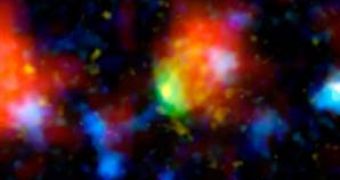Currently, our Milky Way galaxy is thought to produce about 10 new stars every year, close to nothing compared to a newly found distant galaxy that appears to generate approximately 4,000 new stars each year. A small calculation reveals that such a galaxy would require as little as 50 million years to evolve into one equivalent to some of the most massive galaxies in the observable universe, as opposed to the Hierarchical Model regarding galaxy formation saying that galaxies create stars slowly as they merge with remnants from other star clusters.
"This galaxy is undergoing a major baby boom, producing most of its stars all at once. If our human population was produced in a similar boom, then almost all of the people alive today would be the same age," said Peter Capak of NASA's Spitzer Science Center.
The newly found starburst galaxy lies about 12.3 billion light years away and is one of the brightest distant galaxies in the observable universe, while other ones with similar star formation rates are located much closer to us and are more evolved. "If the universe was a human reaching retirement age, it would have been about 6 years old at the time we are seeing this galaxy. Before now, we had only seen galaxies form stars like this in the teenaged universe, but this galaxy is forming when the universe was only a child. The question now is whether the majority of the very most massive galaxies form very early in the universe like the Baby Boom galaxy, or whether this is an exceptional case. Answering this question will help us determine to what degree the Hierarchical Model of galaxy formation still holds true." Capak said.
Newborn stars emit a great deal of ultraviolet radiation in their early stages of life, radiation which is absorbed into interstellar and intergalactic dust, which then starts glowing in infrared light, allowing NASA's Spitzer, Hubble and a variety of ground based telescopes to detect them with relative ease.
"We may be witnessing, for the first time, the formation of one of the most massive elliptical galaxies in the universe," said Nick Scoville of Caltech, part of the research team detailing the discovery.

 14 DAY TRIAL //
14 DAY TRIAL //